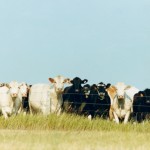For Some Idaho Farmers, This Year’s Drought Means Losses Next Year

Molly Messick / StateImpact Idaho
Last month, Hans Hayden examined wheat yields near his farm in Arbon Valley, near Pocatello.
In Idaho, this summer’s drought has picked winners and losers. In southeast Idaho, farmers with deep wells and sophisticated irrigation systems predicted record profits as harvest time began last month. Meanwhile, dryland farmers nearby contemplated withered spring wheat fields, and hoped to break even.
Now, dryland wheat farmer Hans Hayden says the drought is beginning to cause problems for next season’s crop. “We’ve already lost potential for next season,” Hayden says.
Ideally, his winter wheat crop, which he plants in late summer, would be growing right now. But without rain, there’s no sense in putting seed in the ground. And that cuts into next year’s yields.
“I am losing at least a bushel per day or every other day,” Hayden estimates. What’s more, he faces a shrinking window of time during which he can get the crop in the ground.
“After October 10, we have very little growing season around here,” he explains. “We really don’t have any success if we plant it and it doesn’t come up before spring.”
As for how much rain his fields need before it makes sense to plant — it’s substantial. A quarter of an inch won’t do. An inch of rain would be more like it. So far this year, rainfall in southeast Idaho is roughly five inches below the 30-year average, according to the National Weather Service. That’s significant, given that, in a normal year, between seven and eight inches falls there from January through August.
All of these bad signs for the year ahead create another decision: should Hayden invest more heavily in crop insurance for the coming year?
He usually covers his operation minimally, insuring against all-out economic catastrophe. This year, though, it might make sense for Hayden to shell out the roughly $50,000 it will take to cover the $450,000 he’ll spend getting his crop in the ground. He’s not sure yet what he’ll do. It’s a calculation he’ll have to make by the end of this month.
Hans Hayden isn’t alone in facing uncertainty and tough calls. A Capital Press report published Tuesday surveys several other dryland wheat growers, including Jerry Brown.
“Brown, an Idaho wheat commissioner from Caribou County, is among the many eastern Idaho dryland grain farmers waiting for at least an inch of rain before planting this fall. If sufficient moisture doesn’t come by Oct. 10, he’ll likely save his seed for spring, though winter wheat yields in his region tend to be three times as high.” — Capital Press
Hayden, at least, is keeping up hope. He’s checked the records. There have only been three years out of the last 40 when the first fall moisture came as snow, instead of rain. In other words, the odds are with him. Rain could come yet.


